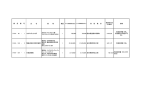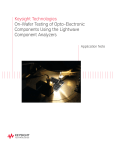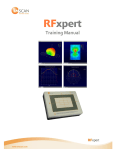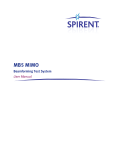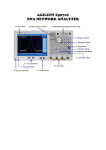Download Agilent Technologies E5071C Installation guide
Transcript
Caution Do not exceed the operating input power, voltage, and current level and signal type appropriate for the instrument being used, refer to your instrument's Function Reference. Electrostatic discharge(ESD) can damage the highly sensitive microcircuits in your instrument. ESD damage is most likely to occur as the test fixtures are being connected or disconnected. Protect them from ESD damage by wearing a grounding strap that provides a high resistance path to ground. Alternatively, ground yourself to discharge any static charge built-up by touching the outer shell of any grounded instrument chassis before touching the test port connectors. Safety Summary When you notice any of the unusual conditions listed below, immediately terminate operation and disconnect the power cable. Contact your local Agilent Technologies sales representative or authorized service company for repair of the instrument. If you continue to operate without repairing the instrument, there is a potential fire or shock hazard for the operator. - Instrument operates abnormally. - Instrument emits abnormal noise, smell, smoke or a spark-like light during operation. - Instrument generates high temperature or electrical shock during operation. - Power cable, plug, or receptacle on instrument is damaged. - Foreign substance or liquid has fallen into the instrument. Herstellerbescheinigung GERAUSCHEMISSION LpA < 70 dB am Arbeitsplatz normaler Betrieb nach DIN 45635 T. 19 Manufacturer's Declaration ACOUSTIC NOISE EMISSION LpA < 70 dB operator position normal operation per ISO 7779 Regulatory compliance information This product complies with the essential requirements of the following applicable European Directives, and carries the CE marking accordingly: The Low Voltage Directive 73/23/EEC, amended by 93/68/EEC The EMC Directive 89/336/EEC, amended by 93/68/EEC To obtain Declaration of Conformity, please contact your local Agilent Technologies sales office, agent or distributor. Safety notice supplement ・ This equipment complies with EN/IEC61010-1:2001. ・ This equipment is MEASUREMENT CATEGORY I (CAT I). Do not use for CAT II, III, or IV. ・ Do not connect the measuring terminals to mains. ・ This equipment is POLLUTION DEGREE 2, INDOOR USE product. ・ This equipment is tested with stand-alone condition or with the combination with the accessories supplied by Agilent Technologies against the requirement of the standards described in the Declaration of Conformity. If it is used as a system component, compliance of related regulations and safety requirements are to be confirmed by the builder of the system. Agilent E5071C ENA Series RF Network Analyzers Installation Guide First Edition Manufacturing No. E5071-90000 October 2006 Notices The information contained in this document is subject to change without notice. This document contains proprietary information that is protected by copyright. All rights are reserved. No part of this document may be photocopied, reproduced, or translated to another language without the prior written consent of Agilent Technologies. Microsoft®,MS-DOS®,Windows®,Visual C++®,Visual Basic®,VBA® and Excel® are registered trademarks of Microsoft Corporation. Java® is registered trademark of Sum Microsystems Corporation. © Copyright 2006 Agilent Technologies Manual Printing History The manual’s printing date and part number indicate its current edition. The printing date changes when a new edition is printed (minor corrections and updates that are incorporated at reprint do not cause the date to change). The manual part number changes when extensive technical changes are incorporated. October 2006 2 First Edition Safety Summary The following general safety precautions must be observed during all phases of operation, service, and repair of this instrument. Failure to comply with these precautions or with specific WARNINGS elsewhere in this manual may impair the protection provided by the equipment. Such noncompliance would also violate safety standards of design, manufacture, and intended use of the instrument. Agilent Technologies assumes no liability for the customer’s failure to comply with these precautions. NOTE The E5071C complies with INSTALLATION CATEGORY II as well as POLLUTION DEGREE 2 in IEC61010-1. The E5071C is an INDOOR USE product. NOTE The LEDs in the E5071C are Class 1 in accordance with IEC60825-1, CLASS 1 LED PRODUCT • Ground the Instrument To avoid electric shock, the instrument chassis and cabinet must be grounded with the supplied power cable’s grounding prong. • DO NOT Operate in an Explosive Atmosphere Do not operate the instrument in the presence of inflammable gasses or fumes. Operation of any electrical instrument in such an environment clearly constitutes a safety hazard. • Keep Away from Live Circuits Operators must not remove instrument covers. Component replacement and internal adjustments must be made by qualified maintenance personnel. Do not replace components with the power cable connected. Under certain conditions, dangerous voltage levels may remain even after the power cable has been disconnected. To avoid injuries, always disconnect the power and discharge circuits before touching them. • DO NOT Service or Adjust the Instrument Alone Do not attempt internal service or adjustment unless another person, capable of rendering first aid and resuscitation, is present. • DO NOT Substitute Parts or Modify the Instrument To avoid the danger of introducing additional hazards, do not install substitute parts or perform unauthorized modifications to the instrument. Return the instrument to an Agilent Technologies Sales and Service Office for service and repair to ensure that safety features are maintained in operational condition. • Dangerous Procedure Warnings Warnings, such as the example below, precede potentially dangerous procedures throughout this manual. Instructions contained in the warnings must be followed. WARNING Dangerous voltage levels, capable of causing death, are present in this instrument. Use extreme caution when handling, testing, and adjusting this instrument. 3 Safety Symbols General definitions of safety symbols used on the instrument or in manuals are listed below. Instruction Manual symbol: the product is marked with this symbol when it is necessary for the user to refer to the instrument manual. Alternating current. Direct current. On (Supply). Off (Supply). In-position of push-button switch. Out-position of push-button switch. A chassis terminal; a connection to the instrument’s chassis, which includes all exposed metal structure. Stand-by. WARNING This warning sign denotes a hazard. It calls attention to a procedure, practice, or condition that, if not correctly performed or adhered to, could result in injury or death to personnel. CAUTION This Caution sign denotes a hazard. It calls attention to a procedure, practice, or condition that, if not correctly performed or adhered to, could result in damage to or destruction of part or all of the instrument. NOTE This Note sign denotes important information. It calls attention to a procedure, practice, or condition that is essential for the user to understand. 4 Certification Agilent Technologies certifies that this product met its published specifications at the time of shipment from the factory. Agilent Technologies further certifies that its calibration measurements are traceable to the United States National Institute of Standards and Technology, to the extent allowed by the Institution’s calibration facility or by the calibration facilities of other International Standards Organization members. Documentation Warranty The material contained in this document is provided "as is," and is subject to being changed, without notice, in future editions. Further, to the maximum extent permitted by applicable law, Agilent disclaims all warranties, either express or implied with regard to this manual and any information contained herein, including but not limited to the implied warranties of merchantability and fitness for a particular purpose. Agilent shall not be liable for errors or for incidental or consequential damages in connection with the furnishing, use, or performance of this document or any information contained herein. Should Agilent and the user have a separate written agreement with warranty terms covering the material in this document that conflict with these terms, the warranty terms in the separate agreement will control. Exclusive Remedies The remedies provided herein are Buyer’s sole and exclusive remedies. Agilent Technologies shall not be liable for any direct, indirect, special, incidental, or consequential damages, whether based on contract, tort, or any other legal theory. Assistance Product maintenance agreements and other customer assistance agreements are available for Agilent Technologies products. For any assistance, contact your nearest Agilent Technologies Sales and Service Office. Addresses are provided at the back of this manual. 5 Typeface Conventions Sample (bold) Boldface type is used when a term is defined or emphasized. Sample (Italic) Italic type is used for emphasis and for titles of manuals and other publications. Sample menu/button/box/tab Indicates a menu/button/box/tab on the screen labeled “Sample” which can be selected/executed by clicking. “menu”, “button”, “box”, or “tab“ may be omitted. [Sample] Indicates the hardkey whose key label is “Sample“. [Sample] > Item Indicates a series of key operations in which you press the [Sample] key, make the item called “Item” on the displayed menu blink by using the [ ↓] or in other ways, and then press the [Enter] key. 6 Contents 1. Introduction Manuals for E5071C . . . . . . . . . . . . . . . . . . . . . . . . . . . . . . . . . . . . . . . . . . . . . . . . . . . . . . . . . . . . . . . . . . . 10 Contents of This Manual. . . . . . . . . . . . . . . . . . . . . . . . . . . . . . . . . . . . . . . . . . . . . . . . . . . . . . . . . . . . . . . . 10 2. Installation Checking the Shipment . . . . . . . . . . . . . . . . . . . . . . . . . . . . . . . . . . . . . . . . . . . . . . . . . . . . . . . . . . . . . . . . . 13 Environmental Requirements . . . . . . . . . . . . . . . . . . . . . . . . . . . . . . . . . . . . . . . . . . . . . . . . . . . . . . . . . . . . 14 Operating Environments . . . . . . . . . . . . . . . . . . . . . . . . . . . . . . . . . . . . . . . . . . . . . . . . . . . . . . . . . . . . . . 14 Ventilation Requirements . . . . . . . . . . . . . . . . . . . . . . . . . . . . . . . . . . . . . . . . . . . . . . . . . . . . . . . . . . . . . 15 Protection Against Electrostatic Discharge (ESD) . . . . . . . . . . . . . . . . . . . . . . . . . . . . . . . . . . . . . . . . . . 16 Ensuring Adequate Free Space around Analyzer for Immediate Disconnection of Power Cable in Case of Emergency. . . . . . . . . . . . . . . . . . . . . . . . . . . . . . . . . . . . . . . . . . . . . . . . . . . . . . . . . . . . . . . . . . . . . . . . . 16 Installing Front Handles/Rack Mounting Flanges . . . . . . . . . . . . . . . . . . . . . . . . . . . . . . . . . . . . . . . . . . . . 17 How to Install the Handle Kit (Option 1CN) . . . . . . . . . . . . . . . . . . . . . . . . . . . . . . . . . . . . . . . . . . . . . . 18 How to Install the Rack-mount Kit (Option 1CM) . . . . . . . . . . . . . . . . . . . . . . . . . . . . . . . . . . . . . . . . . . 19 How to Install the Rack-mount and Handle Kit (Option 1CP) . . . . . . . . . . . . . . . . . . . . . . . . . . . . . . . . . 19 Connecting the Accessaries . . . . . . . . . . . . . . . . . . . . . . . . . . . . . . . . . . . . . . . . . . . . . . . . . . . . . . . . . . . . . 20 Connecting the BNC Adaptor (Option 1E5) . . . . . . . . . . . . . . . . . . . . . . . . . . . . . . . . . . . . . . . . . . . . . . . 20 Connecting Mouse and Keyboard . . . . . . . . . . . . . . . . . . . . . . . . . . . . . . . . . . . . . . . . . . . . . . . . . . . . . . . 20 Power Supply . . . . . . . . . . . . . . . . . . . . . . . . . . . . . . . . . . . . . . . . . . . . . . . . . . . . . . . . . . . . . . . . . . . . . . . . 21 Verification of the Power Supply . . . . . . . . . . . . . . . . . . . . . . . . . . . . . . . . . . . . . . . . . . . . . . . . . . . . . . . 21 Verification and Connection of Power Cable . . . . . . . . . . . . . . . . . . . . . . . . . . . . . . . . . . . . . . . . . . . . . . 21 Starting the E5071C . . . . . . . . . . . . . . . . . . . . . . . . . . . . . . . . . . . . . . . . . . . . . . . . . . . . . . . . . . . . . . . . . . . 23 Turning the Power ON and OFF . . . . . . . . . . . . . . . . . . . . . . . . . . . . . . . . . . . . . . . . . . . . . . . . . . . . . . . . 23 Disconnection from Supply Source. . . . . . . . . . . . . . . . . . . . . . . . . . . . . . . . . . . . . . . . . . . . . . . . . . . . . . 24 Initial Registration of E5071C . . . . . . . . . . . . . . . . . . . . . . . . . . . . . . . . . . . . . . . . . . . . . . . . . . . . . . . . . . . 25 Calibration of the Touch Screen . . . . . . . . . . . . . . . . . . . . . . . . . . . . . . . . . . . . . . . . . . . . . . . . . . . . . . . . . . 27 3. Troubleshooting Troubleshooting during Startup . . . . . . . . . . . . . . . . . . . . . . . . . . . . . . . . . . . . . . . . . . . . . . . . . . . . . . . . . . 30 System Recovery . . . . . . . . . . . . . . . . . . . . . . . . . . . . . . . . . . . . . . . . . . . . . . . . . . . . . . . . . . . . . . . . . . . . . 31 Types of system recoveries . . . . . . . . . . . . . . . . . . . . . . . . . . . . . . . . . . . . . . . . . . . . . . . . . . . . . . . . . . . . 31 Notes on executing the factory recovery function . . . . . . . . . . . . . . . . . . . . . . . . . . . . . . . . . . . . . . . . . . 31 Procedure to execute the factory recovery . . . . . . . . . . . . . . . . . . . . . . . . . . . . . . . . . . . . . . . . . . . . . . . . 32 Procedure to create the user backup image . . . . . . . . . . . . . . . . . . . . . . . . . . . . . . . . . . . . . . . . . . . . . . . . 34 Procedure to execute the user recovery function . . . . . . . . . . . . . . . . . . . . . . . . . . . . . . . . . . . . . . . . . . . 40 7 Contents 8 1. Introduction 1 Introduction This chapter introduces the documentation for Agilent E5071C and the overview of this manual to use this manual efficiently. See this manual first when you use the E5071C for the first time. 9 Introduction Manuals for E5071C Manuals for E5071C Agilent provides the following three manuals for E5071C. The latest version of all documentations can be downloaded from http://www.agilent.com/find/ena_support/. R Installation Guide The installaton guide (this manual) provides start up setup information when you use the E5071C for the first time and troubleshooting information when the Windows cannot be boot up. R Online Help The online help provides the information about the measurement operation, programming, built-in VBA, I/O interface This is pre-installed in the E5071C. Press [Help] hard key on the fron panel to open. R Service Guide The service manual provides information about the parts, troubleshooting, performance test, adjustment and service menu. Contents of This Manual The following shows the contents of this manual. R Chapter 1, “Introduction” This chapter introduces the documentation for Agilent E5071C and the overview of this manual to use this manual efficiently. See this manual first when you use the E5071C for the first time. R Chapter 2, “Installation” This chapter provides information about how to set up the Agilent E5071C. R Chapter 3, “Troubleshooting” This chapter describes the troubleshooting during start up and the procesure of the operating system (OS) recovery when the Windows XP OS has been damaged. 10 Chapter 1 2. Installation 2 Installation This chapter provides information about how to set up the Agilent E5071C. 11 Installation Contents of this Chapter R Checking the Shipment on page 13 After you receive the analyzer, check all the items in the packing container. R Environmental Requirements on page 14 Describes the system requirements needed to install the E5071C and how to secure space for heat radiation. R Installing Front Handles/Rack Mounting Flanges on page 17 Shows how to mount the front handles used to transport the E5071C and how to install the flanges needed to install it in a rack. R Connecting the Accessaries on page 20 Provides information for connecting the mouse, keyboard, BNC adaptor to the E5071C. R Power Supply on page 21 Shows how to check the power supply as well as check and connect the power cable. R Starting the E5071C on page 23 Describes turning on/off of the Power switch and cutting off the power supply. R Initial Registration of E5071C on page 25 Provides the procedure of intitial registaration for the Windows XP operating system of the E5071C. R Calibration of the Touch Screen on page 27 Provides the procedure of touch screen calibration. 12 Chapter 2 Installation Checking the Shipment Checking the Shipment After you receive the analyzer, carry out checks during unpacking according to the following procedure. WARNING Step 1. Check that the packing box or shock-absorbing material used to package the analyzer has not been damaged. NOTE If the packing box or shock-absorbing material has been damaged, leave the packing box and shock-absorbing material as is until other inspection items are checked as follows: Step 2. Check the packaged items supplied with the analyzer for any damage or defects. Step 3. By referring to the furnished contents list, check that all packaged items supplied with the analyzer have been provided as per the specified options. Step 4. After checking, if one of the following applies, contact your nearest Agilent Technologies sales and service office. 1. The packing box or shock-absorbing material used to package the analyzer has been damaged or the shock-absorbing material has traces where extreme force has been applied. 2. A packaged item supplied with the analyzer has mechanical damage or defects. 3. A packaged item supplied with the analyzer is missing. 4. A fault has been detected in the subsequent operation check of the analyzer. If an abnormality is detected in step 1, contact the company that transported the analyzer as well as your nearest Agilent Technologies sales and service office. For inspection by the transport company, save the packing box, shock-absorbing material, and packaged items as you received them. Chapter 2 13 2. Installation When unpacking the analyzer, if the external face of the analyzer (such as the cover, front/rear panel, LCD screen, power switch, and port connectors) appear to be damaged during transport, do not turn on the power switch. Otherwise, you may get an electric shock. Installation Environmental Requirements Environmental Requirements Set up the E5071C where the following environmental requirements are met. Operating Environments Ensure that the operating environment meets the following requirements. NOTE Temperature 5 °C to 40 °C Temperature range at the error-correction 23 °C ± 5 °C (< 1 °C deviation from the temperature when performing the error-correction) Humidity 20% to 80% at wet bulb temperature < +29 °C (non-condensation) Altitude 0 to 2,000 m (0 to 6,561 feet) Vibration 0.21 G maximum, 5 Hz to 500 Hz Above environmental requirements are NOT for the specifications and measurement accuracy of the analyzer, but for the operating environment of the analyzer. 14 Chapter 2 Installation Environmental Requirements Ventilation Requirements To ensure safety requirements, the specifications and measurement accuracy of the analyzer, you must keep environmental temperature within the specified range by providing appropriate cooling clearance around the analyzer or, for the rackmount type, by forcefully air-cooling inside the rack housing. For more information on environmental temperature to satisfy the specifications and measurement accuracy of the analyzer, see the specification in the E5071C Online Help. Requirements Figure 2-1 Back ≥ 180 mm Sides ≥ 60 mm (both right and left) Ventilation space at the installation ACTIVE CH/TRACE RESPONSE ENTRY NAVIGATION OO OO Softkey On/Off STIMULUS MKR/ANALYSIS INSTR STATE Capture PORT 1 PORT 2 PORT 3 PORT 4 USB PROBE POWER + 26 dBm RF 35 VDC Max Avoid Static Discharge CAT Σ OO e5071cqe1001 Chapter 2 15 2. Installation When the environmental temperature around the analyzer is kept within the temperature range of the operating environment specification (See Section “Operating Environments” on page 14), the analyzer conforms to the requirements of the safety standard. Furthermore, under that temperature requirement, the analyzer still conforms to the requirements of the safety standard even when placing the analyzer with cooling clearance as follows: Installation Environmental Requirements Protection Against Electrostatic Discharge (ESD) Set up a static-safe work-station to protect the electronic components from the damage by the electrostatic discharge (ESD) as shown in Figure 2-2. Table 2-1 shows the accessories available that provide ESD protection. Table 2-1 The accessories available that provide ESD protection Name Figure 2-2 Agilent Part Number Static-control table mat and earth ground wire 9300-0797 Wrist-strap cord 9300-0980 Wrist-strap 9300-1383 Heel-straps 9300-1169 Example of the static-safe work-station Ensuring Adequate Free Space around Analyzer for Immediate Disconnection of Power Cable in Case of Emergency As described in “Disconnection from Supply Source” on page 24, the power supply is disconnected by removing the power cable’s connector plug from either the AC outlet or the E5071C unit. When installing the E5071C, ensure that there is sufficient free space around the unit to permit quick disconnection of the plug (from AC outlet or E5071C unit) in case of emergency. 16 Chapter 2 Installation Installing Front Handles/Rack Mounting Flanges Installing Front Handles/Rack Mounting Flanges The E5071C can be installed on a workbench or in a rack. This section describes how to install the front handles (Option 1CN) used for moving or transporting the instrument, and how to install the analyzer in an equipment rack as part of a measurement system (Option 1CM: without the handles, Option 1CP: with the handles). Table 2-2 Agilent E5071C handles/rack mounting options Table 2-3 Name Agilent Part Number 1CN Handle Kit 5063-9229 1CM Rack-mount Kit 5063-9216 1CP Rack-mount and Handle Kit 5063-9223 Contents of each option Option 1CN 1CM 1CP Chapter 2 Contents Quantity Front Handles 2 Screws 6 Trim Strips 2 Rack-mounting flanges (locking side plate) 2 Screws 6 Rack-mounting flanges (locking side plate) 2 Front Handles 2 Screws 8 17 2. Installation Option Installation Installing Front Handles/Rack Mounting Flanges Figure 2-3 Installing front handle/rack-mount kits How to Install the Handle Kit (Option 1CN) The handle kit is used for transport and relocation of the E5071C. While referring to Figure 2-3, install the handle kit by following these steps. Step 1. Remove the adhesive-backed trim strip (1) from each side of the outer frame of the E5071C front panel. Step 2. Use the provided screws to mount the front handles (2) on each side of the E5071C front panel frame. Step 3. Attach the provided modified trim strip (3) to each front handle in order to cover the front panel locking screws. WARNING If the installed front handle becomes damaged, replace it with a new one immediately. A damaged handle can break while moving or lifting the instrument and cause personal injury or damage to the instrument. 18 Chapter 2 Installation Installing Front Handles/Rack Mounting Flanges How to Install the Rack-mount Kit (Option 1CM) The rack-mount kit includes two flanges (locking side plates) for mounting the E5071C on a rack (482.6 mm/19 inches) conforming to the EIA Standard. While referring to Figure 2-3, install the rack-mount kit by following these steps. Step 1. Remove the adhesive-backed trim strip (1) from each side of the outer frame of the E5071C front panel. Step 2. Use the provided screws to mount a rack-mounting flange (4) on each side of the E5071C front panel frame. Step 4. Mount the E5071C on the rack. How to Install the Rack-mount and Handle Kit (Option 1CP) The rack-mount and handle kit includes both the rack-mounting flanges (locking side plates) and front handles. While referring to Figure 2-3, install the rack-mount kit by following these steps. Step 1. Remove the adhesive-backed trim strip (1) from each side of the outer frame of the E5071C front panel. Step 2. Use the provided screws to mount a front handle (2) and rack-mounting flange (4) on each side of the E5071C front panel frame. CAUTION Use both a front handle and a rack-mounting flange in the same time certainly. Do not attempt to install flanges or handles separately with hardware provided. Serious electrical damage will occur to the instrument. Step 3. Remove the four bottom feet of the E5071C (lift the bar marked TAB on the inner side of the foot and slide the foot toward the bar). Step 4. Mount the E5071C on the rack. Chapter 2 19 2. Installation Step 3. Remove the four bottom feet of the E5071C (lift the bar marked TAB on the inner side of the foot and slide the foot toward the bar). Installation Connecting the Accessaries Connecting the Accessaries You need to connect some accessaries before use. Connecting the BNC Adaptor (Option 1E5) When the E5071C is equipped with Option 1E5 (high-stability frequency standard), connect the BNC adaptor from the Ref Oven terminal to the Ref In terminal on the rear panel as shown in Figure 2-4. The BNC adaptor is included in Option 1E5. When Option 1E5 is installed, the frequency accuracy and stability of the E5071C will further improve. Figure 2-4 Connecting the BNC adaptor ICES/NMB-001 LR95111C GPIB 4 EXT TRIG IN ISM 1-A N10149 NOTE 24 BIT I/O WARNING: No operator serviceable parts inside. Refer servicing to qualified personnel. Switch must remain ON while operating. USB EXT TRIG OUT 115 V 50/60 Hz - 230 V 350 VA Max LINE Model# Label Serial Label REF IN REF OUT 10 MHz AUX IN 2 AUX IN 1 1 V, 10 V I/O PANEL PRINTER (PARALLEL) RESERVED ETHERNET VIDEO 1 3 2 4 RESERVED Windows Label REF OVEN (10 MHz) BNC adaptor PORT 4 FUSE 0.5 A PORT 3 PORT 2 BIAS INPUT 35 VDC Max PORT 1 e5071cqe1002 Connecting Mouse and Keyboard E5071C allows you to connect Mouse and/or keyboard through USB or PS/2. USB mouse and keyboard can be connected with the USB ports on the front or rear panels. Initial registration of the E5071C requires the mouse and the keyboard before turning on the power. 20 Chapter 2 Installation Power Supply Power Supply Before turning on the E5071C power, check the following. Verification of the Power Supply Confirm that the power supplied to the E5071C meets the following requirements: Voltage 90 to 132 VAC or 198 to 264 VAC *1 Frequency 47 to 63 Hz Maximum power consumption 350 VA 2. Installation Requirements *1. Switched automatically by the E5071C in conformity to the voltage used. Verification and Connection of Power Cable The three-wire power cable attached to the E5071C has one wire serving as a ground. Using this power cable allows the E5071C to be grounded, thereby protecting you against electrical shock from the power outlet. Step 1. Confirm that the power cable is not damaged. WARNING NEVER use a power cable showing any sign of damage. Faulty cables can cause electrical shock. Step 2. Use the supplied cable to connect between the power cable receptacle (Figure 2-6 on page 24) on the rear panel of the E5071C and a three-wire power outlet with the grounding prong firmly connected in the ground slot. WARNING Use the supplied power cable with grounding wire to securely ground the E5071C. Figure 2-5 shows the power cable options. Chapter 2 21 Installation Power Supply Figure 2-5 Power cable options 22 Chapter 2 Installation Starting the E5071C Starting the E5071C This section describes how to turn on/off the E5071C power and how to cut off the power supply in an emergency. Turning the Power ON and OFF Perform the following steps to turn the power ON or OFF. Step 1. Confirm if the Line Switch on the rear panel is on. The switch should always be turned on. Step 2. If the standby switch ( ( ) in the lower-left part of the front panel is in the depressed ) position, press it to put it in the popped up position ( Step 3. Press the standby switch to put it in the depressed position ( ). ). This operation turns ON the power, and the E5071C starts the self-test. Step 4. Confirm that the self-test indicates normal operation. Normal operation is confirmed by the self-test if no error message appears. Turning the Power OFF Step 1. Use either of the following methods to turn the power OFF. • Press the standby switch ( pressed down ( • ) in the lower-left part of the front panel (now in the ) position) to put it in the popped up ( ) position. Click Turn off Computer from Windows Start menu These operations will start the E5071C shutdown process (required software and hardware processes for turning the power off), and the power will turn OFF after a few seconds. NOTE Under normal circumstances, always press the standby switch ( ), or click Turn off Computer from Windows Start menu, to execute the E5071C shutdown process. Never cut off the power supply directly by disconnecting the power cable plug from the rear panel of the unit. If the power supply is cut off directly by disconnecting the power cable plug from the instrument or the AC outlet, the shutdown process is not carried out and there is a risk of damage to the E5071C’s software or hardware. Chapter 2 23 2. Installation Turning the Power ON Installation Starting the E5071C Figure 2-6 Line switch (Always ON) and power cable receptacle Power Cable Receptacle Line Switch: Always ON ( | ) ICES/NMB-001 LR95111C GPIB 4 EXT TRIG IN ISM 1-A N10149 NOTE 24 BIT I/O WARNING: No operator serviceable parts inside. Refer servicing to qualified personnel. Switch must remain ON while operating. USB EXT TRIG OUT 115 V 50/60 Hz - 230 V 350 VA Max LINE Model# Label Serial Label REF IN REF OUT 10 MHz AUX IN 2 AUX IN 1 1 V, 10 V I/O PANEL PRINTER (PARALLEL) RESERVED ETHERNET VIDEO 1 3 2 4 RESERVED Windows Label REF OVEN (10 MHz) PORT 4 FUSE 0.5 A PORT 3 PORT 2 BIAS INPUT 35 VDC Max PORT 1 e5071cqe1003 Disconnection from Supply Source The power supply of the E5071C is cut off by disconnecting the plug of the power cable (on either AC outlet side or E5071C side). When it is necessary to disconnect the power supply in order to avoid shock hazards, etc., pull out the power cable plug from either the AC outlet side or the E5071C side. NOTE To allow this operation to be performed smoothly, be sure to follow the guidelines in “Ensuring Adequate Free Space around Analyzer for Immediate Disconnection of Power Cable in Case of Emergency” on page 16. When turning the power OFF under normal circumstances, always follow the methods described in “Turning the Power OFF” on page 23. 24 Chapter 2 Installation Initial Registration of E5071C Initial Registration of E5071C When you start up the E5071C at the first time, you need to perform the initial registration of the Windows XP operating system of the E5071C. You cannot use the front panel keys during the initial registration of the E5071C therefore connect the mouse and the keyboard before turning on the power. NOTE If you perform the following procedure incorrectly, a message asking you whether to return to the previous registration screen and perform the registration appears. In this case, follow the instruction to return to the previous registration screen. Step 1. Turns on the E5071C. Step 2. The Windows XP Professional Setup wizard appears. Click the Next > button (Figure 2-7). Figure 2-7 Windows XP Professional Setup wizard e5071cse1073 Chapter 2 25 2. Installation NOTE Installation Initial Registration of E5071C Step 3. In the Windows XP Professional Setup dialog box, select the I accept this agreement box and click the Next > button (Figure 2-8). Figure 2-8 Windows XP Professional Setup dialog box (1/2) e5071cse1074 Step 4. In the next dialog box , input agena in the Name box. Then, click the Next> button (Figure 2-9). Figure 2-9 Windows XP Professional Setup dialog box (2/2) e5071cse1075 Step 5. After a while, the E5071C restart automatically. Then, the measurement display appears. 26 Chapter 2 Installation Calibration of the Touch Screen Calibration of the Touch Screen After E5071C measurement screen appears, you have to calibrate the touch screen. Follow the procedure described below to calibrate the touch screen. Step 1. Press . Step 2. Press Service Menu. 2. Installation Step 3. Press Test Menu. Step 4. Press Adjust Touch Screen. The touch screen calibration screen (Figure 2-10) appears. Figure 2-10 Touch Panel Calibration Screen e5071cse1078 Step 5. Touch the x mark on the upper left with your finger. The mark x appears also on the upper right, lower left, and lower right. Touch the x marks in that order with your finger. Touching the four locations described above with your finger automatically concludes the touch screen calibration. NOTE With no operation on the touch screen calibration screen for a preset time, it automatically closes and the previous measurement screen reappears. Chapter 2 27 Installation Calibration of the Touch Screen 28 Chapter 2 1. Chapter 1 2. Chapter 2 3. Troubleshooting 3 Troubleshooting 5. Chapter 5 This chapter describes the troubleshooting during start up and the procesure of the operating system (OS) recovery when the Windows XP OS has been damaged. 29 Troubleshooting Troubleshooting during Startup Troubleshooting during Startup When you encounter the problem during start up, see Table 3-1. System recovery saves most of problems. Table 3-1 Troubleshooting during startup Symptom Solution Turning on (|) the standby switch does not start up the system. Confirm that the power cable is properly plugged in. Confirm that the line switch on the rear panel is turned on The system starts up, but it automatically shuts down immediately. Execute the system recovery. The system starts up, but it enters the service mode (The instrument status bar in the lower right part of the screen displays SVC in red). The measurement screen appears after startup, but the power-on test is failed, with Error Message 241 appearing against a red background in the instrument message/warning area in the lower left part of the screen. 30 Chapter 3 1. Chapter 1 Troubleshooting System Recovery System Recovery By executing system recovery, you can return the system of the E5071C (the Windows operating system and the firmware) to the factory state (at the time of purchase*1). 2. Chapter 2 Types of system recoveries The following 2 types of system recoveries are available. R Factory recovery Returns the contents of the C and D drives to the factory state. R User recovery Returns the contents of the C and D drives to a user-specified state. To use this function, you must prepare for recovery in advance. For information on the preparation, see “Procedure to create the user backup image” on page 34 for information on the execution, see “Procedure to execute the user recovery function” on page 40. Executing the factory recovery function causes the following conditions: R In addition to the Windows operating system and the firmware, the following settings of the E5071C are returned to the factory state. • • • Network setting GPIB setting Printer setting 3. Troubleshooting Notes on executing the factory recovery function R The driver for the supported printer installed after purchase is deleted. Files you created using the save function (files in the D drive) are not affected, but we recommend backing them up before executing system recovery for precautionary purposes. For more information on backup, refer to “Backing Up the Data” as described in E5071C Online Help. 4. Chapter 4 R You need to execute initial registration again. 5. Chapter 5 *1.If the hard disk failed and has been replaced after purchase, the state when the replacement was performed is recovered. Chapter 3 31 Troubleshooting System Recovery Procedure to execute the factory recovery This section describes how to return the contents of the C and D drives to the factory state. NOTE You need a keyboard and mouse for this operation. Step 1. Shut down the E5071C. Step 2. Connect the keyboard and mouse to the E5071C. Step 3. Press the standby switch of the E5071C to turn it on. Step 4. When the screen as shown in the figure below appears, press F11 of the keyboard. Starting Acronis Loader... Press F11 for Acronis Startup Recovery Manager... e5071cse1055 NOTE After several seconds, the next screen appears automatically even if you do not press any key, so do not miss it. Step 5. Click Restore. Figure 3-1 Activate Acronis Startup Recovery Manager e5071cse1079 Step 6. A confirmation dialog box is displayed. Click Yes to start the recovery of the factory backup. The recovery takes a few minutes depending on the amount of data. 32 Chapter 3 Figure 3-2 Recover Factory Backup 1. Chapter 1 Troubleshooting System Recovery 2. Chapter 2 e5071cse1034 Step 7. When the recovery is finished, click OK. The E5071C restarts automatically. Step 8. After restart, the screen for initial registration appears. Execute initial registration. For information on the execution procedure, refer to “Initial Registration of E5071C” on page 25. CAUTION Never turn off the power during the system recovery because doing so may cause serious damage to the E5071C. 3. Troubleshooting Step 9. Execute the calibration of the touch screen. For information on the execution procedure, refer to “Calibration of the Touch Screen” on page 27. 4. Chapter 4 5. Chapter 5 Chapter 3 33 Troubleshooting System Recovery Procedure to create the user backup image This section describes how to create the user backup image. The C and D drives’ contents saved in this procedure are recalled when the user recovery function is executed. Step 1. Close the E5071C application by pressing System > Service Menu > Exit. Step 2. Close all other applications you currently open. Step 3. From the Windows start menu, select All Programs > Acronis > Acronis True Image. Step 4. Click “No, Thanks” button. Figure 3-3 Recover User Backup e5071cse1080 Step 5. Click Backup e5071cse1125 34 Chapter 3 Step 6. Click Next button. 1. Chapter 1 Troubleshooting System Recovery 2. Chapter 2 3. Troubleshooting e5071cse1126 Step 7. Select “The entire disk contents or individual partition,” then click Next button. 4. Chapter 4 5. Chapter 5 e5071cse1127 Chapter 3 35 Troubleshooting System Recovery Step 8. Select the C drive and D drive. e5071cse1128 Step 9. Select the destination folder and input a file name, then click Next button. It is recommended to save the file to a directory which has enough space like the E drive. Also, never save the contents of the drive to the C, D or F drive. e5071cse1129 36 Chapter 3 Step 10. Select “Set the options manually” and click Next button. 1. Chapter 1 Troubleshooting System Recovery 2. Chapter 2 3. Troubleshooting e5071cse1130 Step 11. Select “Backup priority” in the left field and “High” in the right field, then click Next button. 4. Chapter 4 5. Chapter 5 e5071cse1131 Chapter 3 37 Troubleshooting System Recovery Step 12. If necessary, input comments and click Next button. The comments can be omitted. e5071cse1132 Step 13. Click Proceed button. e5071cse1133 38 Chapter 3 Step 14. The following screen appears during backup. 1. Chapter 1 Troubleshooting System Recovery 2. Chapter 2 3. Troubleshooting e5071cse1134 Step 15. The following screen appears when the user backup image was created. Click OK. 4. Chapter 4 e5071cse1135 CAUTION Never turn off the power during creating the user backup image because doing so may cause serious damage to the E5071C. 5. Chapter 5 Chapter 3 39 Troubleshooting System Recovery Procedure to execute the user recovery function Returns the contents of the C and D drives to a user-specified state. To use this function, you must create the user backup image in advance. For more information, see the description “Procedure to create the user backup image” on page 34. Step 1. Close the E5071C application by pressing System > Service Menu > Exit. Step 2. Close all other applications you currently open. Step 3. From the Windows start menu, select All Programs > Acronis > Acronis True Image. Step 4. Click “No, Thanks” button. e5071cse1080 Step 5. Click Recovery. e5071cse1136 40 Chapter 3 Step 6. Click Next button. 1. Chapter 1 Troubleshooting System Recovery 2. Chapter 2 3. Troubleshooting e5071cse1137 Step 7. Select the saved backup image file, then click Next button. 4. Chapter 4 5. Chapter 5 e5071cse1138 Chapter 3 41 Troubleshooting System Recovery Step 8. Select “Restore disks or partitions,” then click Next button. e5071cse1139 Step 9. Select the C drive, then click Next button. e5071cse1143 42 Chapter 3 Step 10. Select the C drive to restore, then click Next button. 1. Chapter 1 Troubleshooting System Recovery 2. Chapter 2 3. Troubleshooting e5071cse1144 Step 11. Select “Active” and click Next button. 4. Chapter 4 5. Chapter 5 e5071cse1145 Chapter 3 43 Troubleshooting System Recovery Step 12. Click Next button. e5071cse1146 Step 13. Select “Yes, I want to assign a logical drive letter to the restored partition” and click Next button. e5071cse1147 44 Chapter 3 Step 14. Select “Yes, I want to restore another partition or hard disk drive,” then click Next button. 1. Chapter 1 Troubleshooting System Recovery 2. Chapter 2 3. Troubleshooting e5071cse1148 Step 15. Select the D drive to restore, then click Next button. 4. Chapter 4 5. Chapter 5 e5071cse1149 Chapter 3 45 Troubleshooting System Recovery Step 16. Select the D drive to restore, then click Next button. e5071cse1150 Step 17. Select “Logical” and click Next button. e5071cse1151 46 Chapter 3 Step 18. Click Next button. 1. Chapter 1 Troubleshooting System Recovery 2. Chapter 2 Step 19. Select “Yes, I want to assign a logical drive letter to the restored partition,” then click Next button. 3. Troubleshooting e5071cse1152 4. Chapter 4 5. Chapter 5 e5071cse1153 Chapter 3 47 Troubleshooting System Recovery Step 20. Select “No, I do not.” and click Next button. e5071cse1154 Step 21. Select “Set the options manually” and click Next button. e5071cse1155 Step 22. Select “Restoration Priority” in the left field and “High” in the right field, then click Next 48 Chapter 3 button. 1. Chapter 1 Troubleshooting System Recovery 2. Chapter 2 3. Troubleshooting e5071cse1156 Step 23. Click Proceed button. 4. Chapter 4 5. Chapter 5 e5071cse1157 Chapter 3 49 Troubleshooting System Recovery Step 24. Click Reboot button. e5071cse1158 CAUTION Never turn off the power during the recovery of the user backup image because doing so may cause serious damage to the E5071C. Step 25. After boot up, perform “Initial Registration of E5071C” on page 25 and “Calibration of the Touch Screen” on page 27. 50 Chapter 3



























































